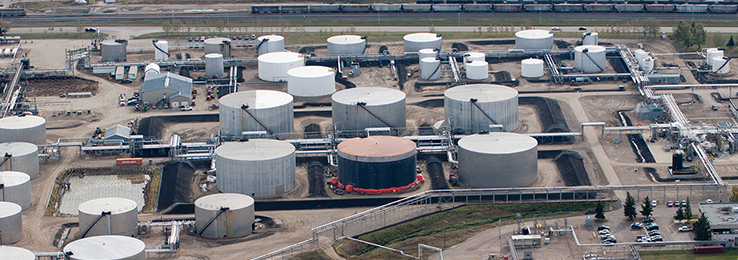Value chain
Our operations involve activities across the full value chain to develop, transport, produce and market crude oil and natural gas in Canada and internationally. Our physically integrated upstream and downstream operations help us mitigate the impact of volatility in the market by capturing value from production through to the sale of finished products, like gasoline, diesel, jet fuel, asphalt and lubricants.
-
Step 1: Unlock and develop
We undertake seismic and exploratory drilling programs to identify the value and location of reserves and to inform our business and development plans.
We engage with our stakeholders and work to obtain regulatory approvals to responsibly develop and commission new facilities, well pads, wells and on-lease pipelines. We also plan for eventual abandonment and reclamation activities.
-
Step 2: Production and operations
We extract our products from a variety of assets and process and transport it, usually by pipeline, to a marketing hub or refinery. Once a project or asset has reached the end of its life, we remove equipment from the site and undertake reclamation and remediation activities.
-
Step 3: Marketing and transportation
Once we get the oil, natural gas and natural gas liquids (NGLs) safely out of the ground, it’s either transported to one of our refineries for further processing or sold to other refiners, large industrial users, wholesalers or commodity purchasers so it can be refined into usable end products. These buyers are located all around the world.
We’re focused on finding new potential buyers, both in North America and around the world. With a variety of safe and economically viable transportation options, we can reach a broader buyer base and secure the highest sale price for our products.
Pipelines
Currently, we move our products on several pipelines across the U.S. and Canada. Pipelines are a safe, economic and environmentally responsible way to transport our products.
We are supportive of all pipeline proposals that would provide additional access to markets. We’re a committed shipper on the approved Trans Mountain Expansion Project and are a 35% owner, and the operator, of Husky Midstream General Partnership, which owns approximately 2,200 kilometres of pipelines, storage terminals and other infrastructure.
Rail
In addition to pipelines, we also transport our oil by rail. Rail transportation allows us to reach customers and refineries located in areas that aren’t connected to a major pipeline.
We own the Bruderheim Energy Terminal, a crude-by-rail loading facility near Edmonton, Alberta. A third-party service provider manages the rail terminal with the same rigour and attention to safety, environmental performance and operational excellence that we demonstrate in our oil and natural gas production operations.
-
Step 4: Upgrading & refining
Upgrading and refining facilities convert crude oil into usable products such as gasoline to fuel our vehicles, and petroleum byproducts that become the building blocks for the items we rely on every day such as asphalt, smartphones, laundry detergent, contact lenses and clothes. Learn more about our upgrading and refining operations.
-
Step 5: End use and retail
Buyers of our refined products have operations across North America and around the world. This includes end-use fuel products such as gasoline, diesel or jet fuel, as well as products made from petrochemicals such as plastics.
Learn more about Cenovus assets in Canada, the United States and the Asia Pacific region.

